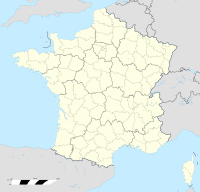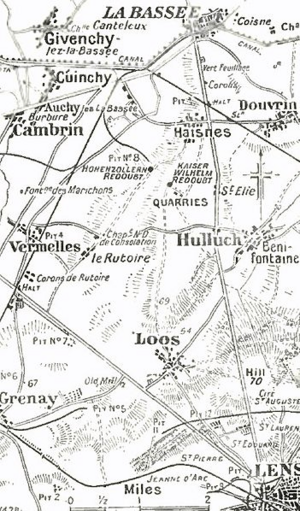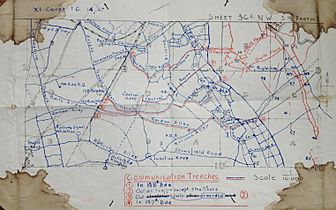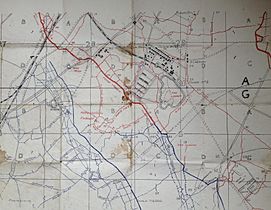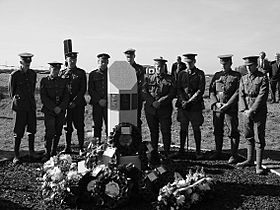Hohenzollern Redoubt facts for kids
Quick facts for kids Hohenzollern Redoubt |
|
|---|---|
| Part of First World War | |
| France Near Auchy-les-Mines, France |
|

Map of the Hohenzollern Redoubt, October 1915
|
|
| Coordinates | 50°29′54.29″N 02°46′29.71″E / 50.4984139°N 2.7749194°E |
| Site information | |
| Controlled by | German 6th Army |
| Site history | |
| Built by | Westheer |
| In use | 1915–1918 |
| Battles/wars | Loos, 1915 |
The Hohenzollern Redoubt (which means "Hohenzollern Work" in German) was a very strong fortification built by the German army during the First World War. It was located in France, near the towns of Auchy-les-Mines and Loos-en-Gohelle.
This important German position was named after the House of Hohenzollern, a famous German royal family. Both German and British soldiers fought fiercely to control it. Battles here happened from the time of the Battle of Loos in late 1915 until the start of the Battle of the Somme in July 1916. Key fights included the action of the Hohenzollern Redoubt in 1915 and a major British attack in March 1916.
Contents
Why the Redoubt Was Important
During the summer of 1915, the German army worked hard to make their front lines stronger. They built more trenches and fortified positions. This was ordered by General Erich von Falkenhayn, a top German military leader.
Some German generals didn't like this idea at first. They thought it might make soldiers want to retreat instead of fight. But after seeing how powerful Allied artillery was, they agreed to build more defenses. A second line of defense was also built a few kilometers behind the main front. This was to make it harder for attackers to move their big guns forward.
German Defenses in 1915
The area around Loos-en-Gohelle had many coal mines. These mines had tall piles of waste rock called "The Dump." Both sides dug tunnels into these piles to create good lookout spots and places for machine guns. "The Dump" was about 6 meters (20 feet) high and offered a great view.
After big battles in May and June 1915, new defenses were built quickly. The Hohenzollern Redoubt was one of these new, very strong positions. It was built on a small hill about 365 meters (400 yards) in front of the old German line. This redoubt was designed to be defended from all sides. It was about 275 meters (300 yards) long and connected to other trenches. British military planners thought the Hohenzollern Redoubt was one of the strongest defenses on the entire front.
Major Battles for the Redoubt
The Hohenzollern Redoubt saw some of the toughest fighting of the war. Many soldiers were lost trying to capture or defend this key position.
British Attacks in October 1915
During the Battle of Loos in late 1915, British forces launched a big attack on the Hohenzollern Redoubt. This battle lasted from October 13 to October 19, 1915. The British 9th (Scottish) Division managed to capture the redoubt, but then lost it again to a German counter-attack.
The final British attack on October 13 failed badly. It caused 3,643 casualties, mostly in the first few minutes. Historians later said that this fighting didn't help the overall situation. It only led to a "useless slaughter of infantry." Heavy rain and German shelling stopped any more attacks.
British Attacks in March 1916
Over the winter, British soldiers from the 170th Tunnelling Company dug many tunnels under the German lines. The Hohenzollern Redoubt had changed hands several times since September 1915. By March 1916, the British held the west side, and the Germans held the east.
On March 2, four large British mines were exploded under the German lines. This was followed by a British advance. The 12th Division wanted to capture the craters created by the explosions. They hoped to get a better view of German defenses. However, German counter-attacks pushed the British back by March 6.
On March 18, the Germans surprised the British by exploding five of their own mines. The fighting around these craters was very costly for both sides. When the fighting finally calmed down, both armies held parts of the crater edges.
Later Operations in 1916
After the British attacks in March, the German forces at the Hohenzollern Redoubt were greatly strengthened. The German soldiers there stayed on high alert for weeks. On March 19, 1916, the British exploded another mine. The Germans then exploded two mines on March 24.
More mines were blown up by both sides in March and April 1916. Each explosion was followed by infantry attacks. These fights were very costly and turned "no man's land" into a field of craters. The British 12th Division was finally replaced on April 26, 1916. They missed the German gas attacks at Hulluch that started the next day, close to the redoubt. Fighting continued until the summer. Then, British and Commonwealth forces moved their focus south to prepare for the Battle of the Somme.
Victoria Cross Heroes
The Victoria Cross is the highest award for bravery in the British military. The following soldiers received this award for their actions at the Hohenzollern Redoubt:
- October 13, 1915: Corporal James Lennox Dawson (from the Corps of Royal Engineers).
- October 14, 1915: Captain Geoffrey Vickers (from The Sherwood Foresters).
- September 27, 1915: Corporal James Dalgleish Pollock (from the Queen's Own Cameron Highlanders).
Remembering the Fallen
Soldiers who went missing in this area are remembered on the Loos Memorial. On October 13, 2006, a special memorial was unveiled. It honors the soldiers of the 46th (North Midland) Division who were lost on October 13, 1915. This was the 91st anniversary of their final attack.
The memorial was designed by Michael Credland. It looks like a broken column made of stone, about 1.17 meters (46 inches) tall. A broken column often means the loss of a family member or an army unit. The angle of the cut at the top is 46 degrees, matching the division's number. The words "Their Country Found Them Ready" are carved on the memorial. This phrase comes from the famous 1915 song "Keep the Home Fires Burning".
Images for kids
-
Trench map showing British lines, carried by Captain Charles Geoffrey Vickers.


